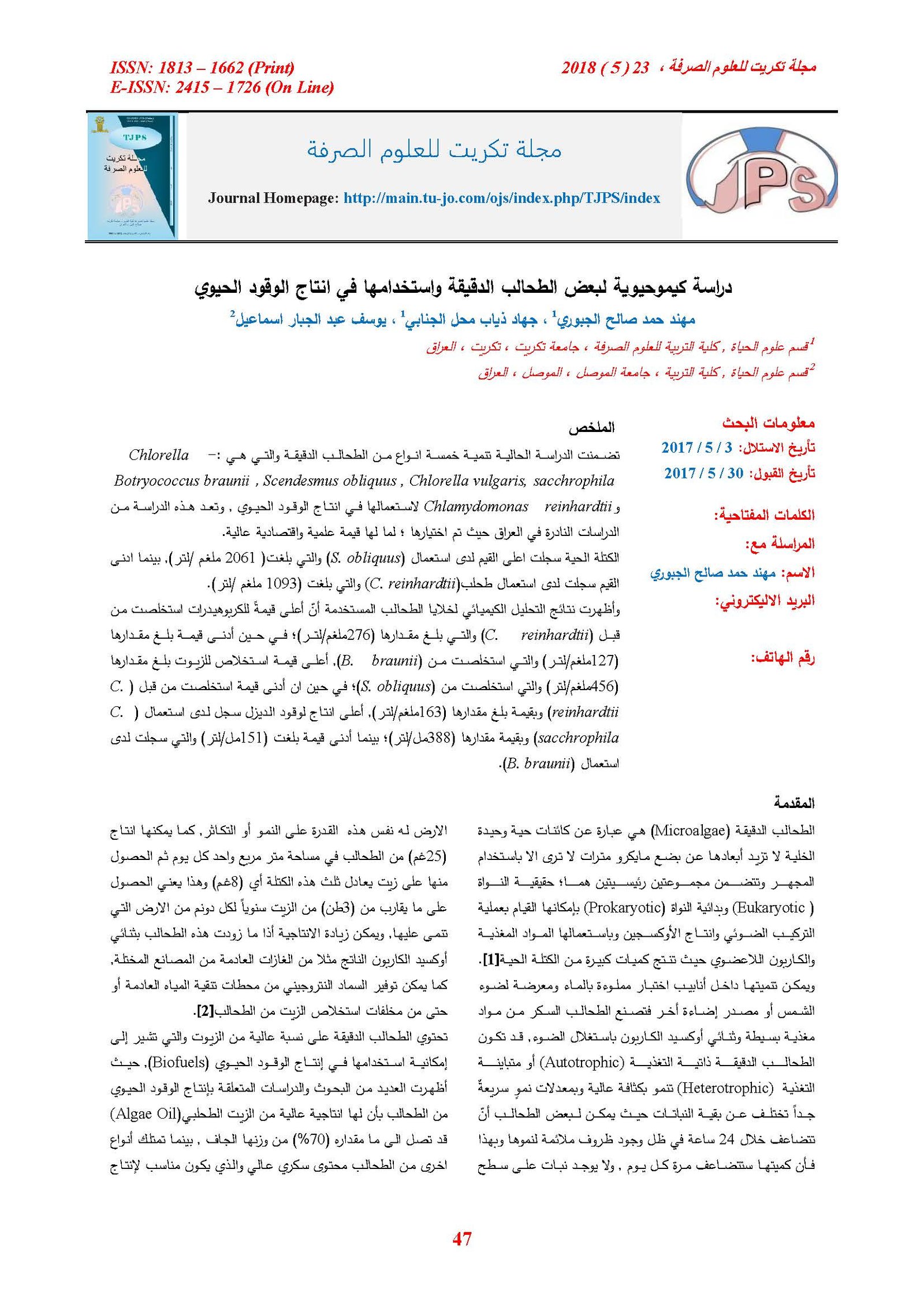Biochemical study of some microalgae and using it production of biofuel
Main Article Content
Abstract
The present study includes growing five species of microalgae which are Chlorella sacchrophila, Chlorella vulgaris , Scendesmus obliquus , Botryococcus braunii and Chlamydomonas reinhardtii algae and using it of figure out processing biofuels. The study is considered as a seldom study in Iraq. The study is chose and focused for its high scientific and economical value.
Algae biomass registers a high value when using S. obliquus (2061mg/l) , while the lowest value were register when using C. reinhardtii which was (1093 mg/l).
Results of chemical analysis show algae cells the highest value for carbohydrate extracts was C. reinhardtii which is (276mg/l), while the lowest value extractive was in B. braunii which is about (127mg/l).The highest value for lipid extracts register by S. obliquus which is (456mg/l), while the lowest value register by C. reinhardtii which is (163 mg/l). The high value production for biodiesel was registered (388 ml/L) when using C. sacchrophila, while the lowest production of biodiesel value was registered (151 ml/L) when using B. braunii.
Article Details

This work is licensed under a Creative Commons Attribution 4.0 International License.
Tikrit Journal of Pure Science is licensed under the Creative Commons Attribution 4.0 International License, which allows users to copy, create extracts, abstracts, and new works from the article, alter and revise the article, and make commercial use of the article (including reuse and/or resale of the article by commercial entities), provided the user gives appropriate credit (with a link to the formal publication through the relevant DOI), provides a link to the license, indicates if changes were made, and the licensor is not represented as endorsing the use made of the work. The authors hold the copyright for their published work on the Tikrit J. Pure Sci. website, while Tikrit J. Pure Sci. is responsible for appreciate citation of their work, which is released under CC-BY-4.0, enabling the unrestricted use, distribution, and reproduction of an article in any medium, provided that the original work is properly cited.
References
1-Soeder, C. J. (2001). Productivity of microalgal systems. In Wastewater for aquaculture. University of the OFS, Bloemfontein: University of the OFS Publication, Series C, No. 3.
3- Demirbas, A. (2010). Use of algae as biofuel sources. Energy conversion and Management, 51: 2738-2749.
6- Bark, M. (2012). Cultivation of eleven different species of freshwater microalgae using simulated flue gas mimicking effluents from paper mills as carbon source. M.S.c. Department of Chemical and Biological Engineering Chalmers of Technology. Gothenburg, Sweden.
9- Bock, C.; Krienitz, L. and Proschold, T. (2011). Taxonomic reassessment of the genus Chlorella (Trebouxiophyceae) using molecular signatures (barcodes), including description of seven new
species. Fottea: Journal of the Czech Psychological Society, 11(2): 293-312.
10- Myers, J. (2000). Growth characteristics of algae in relation to the problems of massculture. In:Algal culture from laboratory to pilot plant, J.S. Burlew (Ed.), Carnegie Institution of Washington #600, Washington, DC Cassidy, 2011.
11- Graham, L.E. and Wilcox, L.W. (2000). Algae. Prentice-Hall, Inc. upper Suddle River, NJ07458. Wisconsin University.
12- Moronta, R.; Mora, R. and Morales, E. (2006). Response of the microalga Chlorella sorokiniana to pH, salinity and temperature in axenic and non-axenic conditions. Revista de la Facultad de Agronomia, 23:27-41.
13- Celekli, A.; Yavuzatmaca, M. and Bozkurt, H. (2008). Modeling of biomass production by Spirulina platensisas function of phosphate concentrations and pH regimes. Bioresource Technology, 100:3625-3629.
14- John, D. (2011). "Phylum Chlorophyta (Green Algae)," in the freshwater algal flora of the British Isles - An Identification Guide to Freshwater and Terrestrial Algae (Second Edition), New York, Cambridge University Press, pp. 364-765.
15- Oilgae, (2012). "Oilgae Report Academic Edition," Chennai, Tamilnadu, India,.
16- Lowrey, J. and Yildiz, I.(2014). Investigation of heterotrophic cultivation potential of Chlorella vulgaris and Tetraselmischuii in controlled environmental wastewater growth media from dairy, poultry and aquaculture industries. Department of Engineering, Faculty of Agriculture Dalhousie University. Nova Scotia, Canada, B2N 5E3.
17- Herbert, D.; Phipps, P. and Strange, R.(1976). "Chemical analysis of microbial cells," In Methods in microbiology, Vol 5B, pp. 209-344.
18- Bligh, E. G.; Dayer, W. J. (1959). A rapid method for total lipid extraction and purification. Can J Biochem. Physiol. 37:911-917.
19- IEA. (2008). World Energy Outlook 2008. Paris: International Energy Agency.
20- Nandini, S.; Ramirez-Garcia, P. and Sarma, S.S. (2010). Evaluation of primary and secondary production using wastewater as a culture medium. Waste Management and Research 28, 928-935.
21- Alhattab, M. (2014). Production of Oil from Freshwater and Marin water microalgae for biodiesel production. Master of Applied Science. Dalhousie University , Halifax, Nova Scotia. Canada.
22- Mathews, C.; Holde van, K. and Ahern, K.(2013). Biochemistry Third Edition, San Francisco: Addison-Wesley Publishing Company.
23- Brown, M.; Jeffrey, S.; Volkman, J. and Dunstan, G. (1997). Nutritional properties of microalgae for mariculture . Aquacult., 151: 315-331.
24- Huang, G.; Chen, F.; Wei, D.; Zhang, X. and Chen, G.(2013). "Biodiesel production by microalgal biotechnology," Applied Energy 87, p. 38–46.
25- Mehrotra, S.; Verma, N.; Shukla, A. and Mishra, B. (2013). "Prospective of biodiesel production utilizing microalgae as the cell factories: A comprehensive discussion," African Journal of Biotechnology Vol. 9,pp. 1402-1411.
26- Patil, V.; Tran, K. and Giselrqd, H.(2008). Towards Sustainable Production of Biofuels from Microalgae. Int. J. Mol. Sci.9, pp. 1188-1195.
28- Venkataraman, L. and Becker, E. (1985). Biotechnology and utilization of algae the indian experience. New Delhi and central food technology research institute , Mysore , India , 257.
29- Illman, A. M.; Scragg, A. H. and Shales, S. W. (2003). Increase in Chlorella strains calorific values when grown in low nitrogen medium. Enzyme Microbial Technology, 27, 631-635.
30- Metzger, P. and Largeau, C. (2004). "Botryococcus braunii: a rich source for hydrocarbons and related ether lipids," Appl Microbiol Biotechnol, vol. 66: 486–496.
